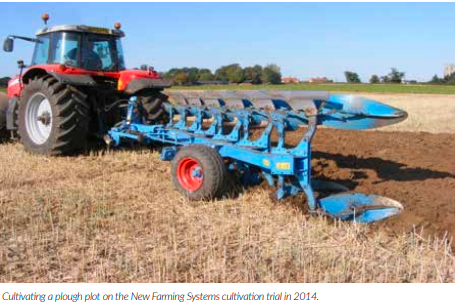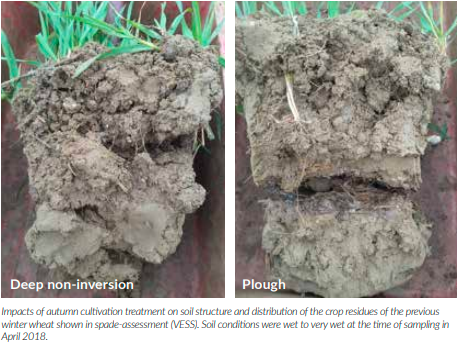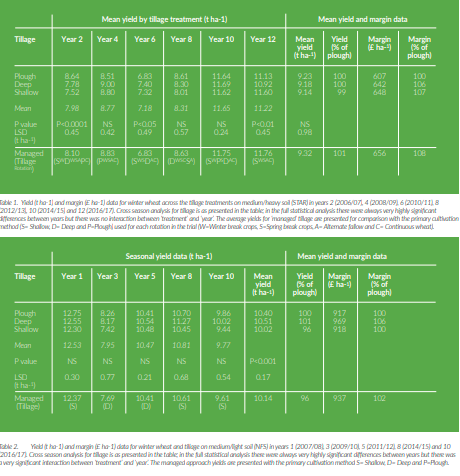By Nathan Morris, Elizabeth Stockdale, David Clarke – NIAB
Long term findings from field-scale experiments (STAR and NFS) show that while yields with non-inversion tillage are similar in most years to yields with ploughing, when decreased costs of labour and fuel are factored in, gross margins under non-inversion tillage were better than under ploughed systems. Hence non-inversion tillage is advocated under ‘normal’ conditions.

The influence of primary cultivation method on crop yields will no doubt continue to cause debate, but long-term findings from the STAR (Sustainability Trial for Arable Rotations) and NFS (New Farming Systems) projects are giving some hard evidence of impacts across seasons and soil types. The long running STAR project in Suffolk (medium/heavy, clay loam soil) and NFS studies at Morley in Norfolk (medium/light, sandy loam soil) started in 2005 and 2007 respectively. Both studies therefore allow us to study impacts over the long-term and have allowed the impacts of the tillage systems to become established. NIAB co-ordinates and manages these trials but they are funded by a number of charities. The Morley Agricultural Foundation (TMAF) and the JC Mann Trust provide continued support for the NIAB New Farming Systems projects; the Felix Cobbold Trust and, historically, the Chadacre Agricultural Trust provide support for the STAR project.

The STAR and NFS projects are field-scale trials using farm scale equipment and techniques with fully replicated large plots. The experiments have the same primary cultivation treatments; however, the difference in soil type between the two sites provides an important contrast when considering tillage impacts. The proportion of particles of different sizes (soil texture) that make up the soil have a large impact on the soil structure and properties such as trafficability and workability. For example, clay soils usually have more small pores than sandy soils and these can hold on to more water for longer. Soil structure results from the interaction of the mineral particles (sand, silt and clay) with soil organic matter as they aggregate together to form the crumbs, blocks and other aggregates that we see when working the soil. In some ways, it is the gaps (pore space) between these aggregates that is the most important part of structure as the pores control the balance of oxygen and water available to plant roots and soil organisms.

Cultivation has a key role in shaping the soil structure. However, plant roots and some soil organisms (known as ‘ecosystem engineers’) also change the structure of soil by moving through the soil, moving soil particles around and extracting water. Along with a range of physical (drying-wetting) processes, these biological interactions have a central role in soil structure development and create micro-habitats for other soil organisms; in temperate agroecosystems, earthworms are very dominant within this group. In the STAR and NFS trials we are comparing 3 contrasting primary cultivation practices: inversion (c. 25 cm plough) and non-inversion tillage (using the subsoiler / disc-based combination, e.g. Sumo Trio) set either deep (c. 20-25 cm) or shallow (c. 10 cm).
These systems are used typically for primary cultivation each year to give the three main treatments. In addition, each study also has a treatment which allows a ‘managed approach’ where the cultivation system used changes with study, season and crop. The annual cultivation decision in these treatments is based on soil conditions, field assessments, previous cropping, weed burden and local best practice (see Table 1 and 2). Secondary cultivations (e.g. power-harrow, press) are used as needed on a treatment by treatment basis. The specific crop rotations used also differ between the sites, however, in both studies rotations employ only combinable crops and include regular winter wheat alternating with combinable break crops.
Winter wheat yield
In both STAR and NFS the regular cropping of winter wheat in the rotations provides a unique opportunity to examine the impact of primary tillage on long term performance of first wheat yields in large scale fully replicated studies. Statistical analysis has focussed on the ‘consistent systems’ (where treatments have remained the same over this time period). Winter wheat yield data for from harvest years 2, 4, 6, 8, 10 and 12 of STAR project are presented in Table 1. Analogous data from harvest years 1, 3, 5, 8 and 10 of the NFS Cultivations study are presented in Table 2. In both studies, winter wheat yields vary markedly with the season; i.e. year has a statistically significant impact on yield. In terms of the impacts of tillage systems, there is no clear pattern in all years.
Considered on average across seasons, in STAR there is no difference in the yield of the different primary tillage systems. In NFS taken across all years, there is a significant reduction in yield (-4%) in the shallow non-inversion systems compared to the other approaches; however, the difference is not significant in any individual year. This is possibly associated with the lighter soils being more prone to loss of structure where some rectification / management is not used. Overall these findings suggest only small percentage yield reductions with shallow tillage (cf. plough systems) indicating that wheat yields are relatively robust with respect to the tillage approaches assessed on these sites. More data analysis and crop modelling may help to explain the differences in the treatments year by year e.g. in terms of the direct impact on seedbed quality and consequent establishment.
At STAR the managed approach to cultivation gives a slightly higher average yield compared with the treatments where the primary cultivation techniques are applied consistently. At NFS yields are 4% lower under the managed approach compared to deep and plough tillage, possibly as a result of the high proportion of shallow tillage used (3 out of 5 years).
Winter wheat margins
When considering gross margins, both STAR and NFS non-inversion treatments (shallow and deep) resulted in greater margins in first wheat crops compared to the plough. For deep non-inversion treatments this benefit was 6–7% and for shallow non-inversion treatments gain was 1–4%. Margins were also increased in the managed approach compared with the ploughed treatments. However, in addition to margin it should also be noted that ploughing would have also resulted in slower speeds of working (cf. non-inversion tillage systems); this would potentially improve a farmer’s capacity and hence ensure timeliness of operations over the total farm area. This is potentially of greater importance than small differences in rotational margin.
Other impacts
In soils under non-inversion tillage, we found increasing tightness in soils in the upper subsoil; however we also sometimes found large improvements in soil physical conditions over a growing season driven by the growing crop. Where there were no changes in the organic matter inputs, there were no gains in carbon storage over the whole soil profile under noninversion tillage (compared with ploughed systems). However, with non-inversion tillage, organic matter becomes more stratified in the soil with higher amounts in the surface soil and lower amounts at 20-25 cm compared to ploughed plots. Currently herbicides are managing the weed burden on all treatments effectively – however, this year we are monitoring some un-treated areas to assess the role of the primary cultivation strategies on the weed seedbank.

Overall, the work in these studies and others is confirming that alongside decisions about primary cultivations, farming systems that support the biological processes of structure formation and increasing soil organic matter content have been shown to help create resilient soil structures that can both absorb heavy rainfall and hold water in drought; however, there is still a way to go before we have fully uncovered the mechanisms supporting structural resilience.
Acknowledgments and thanks are extended to The Morley Agricultural Foundation (TMAF) and The JC Mann Trust for their continued support of the NIAB New Farming Systems programme; also to The Felix Cobbold Trust and historically The Chadacre Agricultural Trust for their support of the STAR project.
